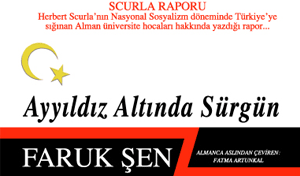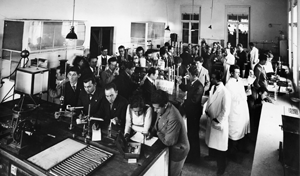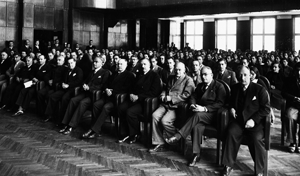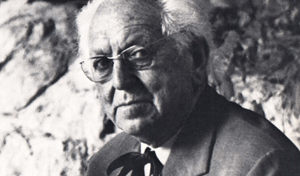"Taking Refuge under the Crescent and Star"
- Written by Admin TOA
- Published in Academicians

A travel report written by Herbert Scurla, an official of the German Ministry of Education who was assigned to Ankara and Istanbul in 1939, clearly demonstrates that while in a large part of Europe, Christian/Western principles and human civilizations were being trod underfoot, this was not the case in Turkey.
Prepared in collaboration with the Asım Kocabıyık Foundation for Culture and Education, this book says that the young Turkish republic represented a peaceful and free refuge where scientists and academics could continue their lives and their studies. The book also stresses the fact that these exiled intellectuals were to bring very real benefits to Turkey in terms of art, architecture and management.
Asım Kocabıyık, who sponsored and supported the printing of this book, says that the persons of science, art and culture who took refuge in Turkey between 1933 and 1935 in an effort to escape from the Nationalist Socialist regime of Germany were to have a huge effect on the 1933 transformation of the Darülfünün school of higher learning into a modern university, in instituting university reforms, and in the academic life of the country in general. Kocabıyık, who was a student at the University of Istanbul during those years, said:
“I was a student in the Department of Economics of the University of Istanbul during the years spanning 1942 – 47 and I had the opportunity to witness first hand the contributions that very valuable scientists like Prof. Fritz Neumark, Prof. Gerhard Kessler, Prof. Alexander Rüstow, Prof. Alfred Isaac and Prof. Wilhelm Röpke had on the founding of our department and on its development. The university’s rector, Prof. Dr. Cemil Bilsel, and the country’s president, İsmet İnönü, both were instrumental in utilizing the services of these very valuable individuals.”
These German scientists left very influential marks on a Turkish academic system that today is served by as many as 80,000 academic staff members who provide education to approximately 2 million students each year. These scientists, who were to establish a deeply rooted system of scientific collaboration between Germany and Turkey, led the rest of their lives as loyal friends of this country and in many respects they became world-wide volunteer ambassadors for this country.
BOOK SOURCES
“Ay – Yıldız Altında Sürgün” sets off with an evaluation of the report written in 1939 by Herbert Scurla, an official from the German Ministry of Education who had been sent to Istanbul and Ankara in Turkey both to report on the activities of the German academic refugees and to force their return.

The book says that, despite the assistance given to Scurla by the German consulate in Istanbul and by the German embassy in Ankara, he was unable to persuade the Turks to end their employment agreements with these German professors and replace them with so-called “trusted” academics, i.e. individuals who were “trusted” because their beliefs adhered to the views of the Nazi government.
Prof. Faruk Şen says, “Scurla was sent to Turkey and charged with determining the ever growing number of German intellectuals who sought refuge in Turkey, either because they were not of so-called Aryan stock or because they opposed the platforms and principles of the Nazi regime, individuals who had no chance of living freely in any other part of Europe. While his report documents his failure, it also today serves as a basic source for information about those intellectuals who took refuge in Turkey. This report was found quite by accident in the 1980s in an archive study carried out to mark Mustafa Kemal Ataturk’s 100th birthday. Published by the Turkish Research Institute in 1987, this report, along with other information and documents, formed the basis for the book he titled, ‘Ay-Yıldız Altında Sürgün.”
Among the other especially interesting aspects of the book is that Edzard Reuter, the son of Ernest Reuter, who was later to serve as mayor of the city of Berlin, contributed towards the printing of this book. Şen tells us, “Prior to the 1940s Reuter worked for the Ministry of Finance as an expert in city planning and later taught at the Department of Political Science at Ankara University. It was because of this that his son, Edzard, spent most of his youth in Turkey. After the war he worked with NGOs that were based on developing Turkish/German relationships.”
DETERMINING THE GERMAN INTELLECTUAL REFUGEES
Scientist Fritz Neumark, who was one of the German intellectuals who had sought refuge in Turkey, wrote his own critique of the Scurla Report. According to Neumark, Scurla had no idea whatsoever of Turkish psychology. “Even though Scurla had countless meetings with Turkish ministers and undersecretaries, he never had any idea at all about Turkish psychology. He had a low opinion of the masterful diplomatic skills of these diplomats and he misunderstood many of their words, taking them for promises. He was often sure that he was on the very point of—or had completely—won his little game. There was only one case I know of when a work contract—they were generally 5-year contracts—was not extended. In this case the German professor had become so ill that he was unable to continue with his duties.

FAMOUS GERMAN SCIENTISTS
Many of the German scientists who had taken refuge in Turkey were to later continue their academic careers in the US. Among these were Romance Languages expert Leo Spitzer (Johns Hopkins University), Richard von Mises (Harvard), Chemist Felix Haurowitz (Indiana), Romance Languages expert A. Auerbach (Yale University) and surgeon Rudolf Nissen.
USA AND TURKEY
Almost all of the German refugees were highly respected professors of world-wide renown. Many of these professors were offered jobs by American universities both before the war broke out and immediately after, while many were also invited to return back to Germany after the war. Many took positions in American universities like Harvard, Princeton, Johns Hopkins, Washington, and Berkeley, where they gained positions of respect. In like manner, those that returned to the newly established Germany Federal Republic also began to teach in their own country and many of these reached high positions within their universities, such as rector.
SOME OF THE FAMOUS GERMAN SCIENTISTS WHO SOUGHT REFUGE IN TURKEY
FRITZ BAADE (1893-1974)
He was invited to Turkey in 1934 by the Turkish Ministry of Agriculture as an agricultural expert. In 1944 he and his family settled in Kırşehir. While in that city, he discovered and unearthed a health-giving spring that had been known in ancient times but which had long since been lost underground. He moved to the United States in 1946 and from 1964 he acted as honorary consul to the Republic of Turkey. While visiting Kırşehir in one of his travels in 1958 he was named an “honorary resident.”
SCULPTOR RUDOLF BELLING (1886-1972)
Rudolph Belling sought refuge in Turkey in January of 1937. In Istanbul he founded the department of sculpture. In 1950 he was invited by the Ataturk Mausoleum commission to do the statue of Ataturk. In 1951 he moved to Istanbul Technical University as an associate professor of Drawing and Sculpting. In 1966 he and his family returned to Germany.
ROMANCE LANGUAGES EXPERT ERICH AUERBACH (1892-1957)
In 1933 he was a professor in Marburg. In 1936 he was invited by the University of Istanbul to come to Turkey where he chaired the department of Romance Languages and Literature. He continued on in Istanbul as an instructor at Robert College. In 1945 he went to the USA to further his education. There he became a professor of Chemistry. In 1949 he was named a member of the Institute of Advanced Studies at Princeton and in 1950 became a professor of Romance Languages at Princeton.
CHEMIST FRIEDRICH BREUSCH (1903 - ?)
In 1933 he was the departmental manager of the Institute of Chemistry at Freiburg University. In 1937 he was received an invitation from the University of Istanbul, where he first established the Institute of Hygiene. He later served as Director and as Professor of the 2nd Chemical Institute, which he himself had set up. In 1953 he participated in the re-institution of the Istanbul German High School. Upon his retirement in 1971, he moved to Switzerland. In 1973 the University of Istanbul presented him with an honorary doctorate.
HISTORIAN CLEMENS BOSCH (1899-1955)
An expert in Ancient History and Numismatology, Clemens Bosch served as an instructor at Halle University in 1933 when he, accompanied by his wife and five children, sought refuge in Turkey. In Istanbul he began working as a numismatist at the Istanbul State Museum of Archaeology. In 1939 he was named Professor of Ancient History at the University of Istanbul. At that same time he converted to Islam and took on a new name, Emin. Bosch continued to teach at the University of Istanbul until his death in 1955.
ARCHITECT MARTIN WAGNER (1885-1957)
In 1935 he came to Turkey as a refugee and was hired as an urban planning expert by the Istanbul Municipality. In that position he carried out traffic analysis, city planning and residential planning for the municipality. His plans, however, were never implemented. In 1938 he was invited to serve as a professor at Harvard University and moved to the USA at that time.
ASTRONOMER ERWIB FINLAY-FREUNDLICH (1885-1964)
Having served as a professor at Berlin University and the director of the Potsdam Observatory, in 1933 he was dismissed from these positions for anti-Semitic reasons and so he and his family sought refuge in Turkey. In Turkey he was named professor at the University of Istanbul and Director of the Institute of Astronomy. After his retirement in 1959, Finlay-Freundlich returned to the Federal German Republic where he served as a honorary professor at Mainz University. He died in 1964 in Mainz.
ATTORNEY ANDREAS BERTOLAN SCHWARZ (1886-1953)
In 1933, while serving as a professor of Law of Roman and German Civilizations at Freiburg University, he was dismissed from his position due to anti-Semitism. In 1934 he entered Turkey as a refugee and was an instructor of Roman Law, Civil Law and Comparative Law in Istanbul. In 1953 he went to Freiburg for one semester as a guest instructor and died there at that time.
ERICH FRANK (1884-1957)
In 1933, while serving as a professor of internal medicine at Breslau University and the departmental head of Internal Medicine at Wenzel-Hancke Hospital, he was dismissed from these positions due to anti-Semitism, at which point he came to Turkey as a refugee. He served as a professor at the School of Medicine of the University of Istanbul and was Clinic Head of the 2nd Internal Medicine Clinic from 1933 until his retirement in 1953. He remained in Turkey following his retirement. When he died in 1957 he was given a state funeral by the Turkish government.
CHEMIST OTTO GERNGROSS (1882-1966)
Born in Vienna, Gerngross became a German citizen after being named professor at Berlin Technical University. In 1932 his university in Berlin assigned him to the Institute of Agricultural Studies in Ankara. In 1938 he decided to remain in Ankara. In 1943 his contract with the Agricultural Institute in Ankara was not extended and it was thus that Gerngross lost his residency rights to remain in Turkey. He went to Palestine where he worked as a chemist. In 1947 he returned to Turkey where he became a professor of chemistry at the newly founded Ankara University. He remained in this position until his death in 1966.
ASTRONOMER WOLFGANG GLEISBERG (1903-1986)
In 1933, while he working as a research assistant at the Observatory of Breslau University, it was learned that one of his grandfathers had been Jewish, so he was dismissed from his position. That same year he came to Turkey and, on the recommendation of Erwin Finlay-Freundlich, was named a research assistant and associate professor at the Institute of Astronomy. Gleissburg was highly influential in finding Turkish equivalents for the technical terms used in the study of astronomy. He was named professor in 1948 and was made head of the Astronomy Institute. He continued to teach at the University of Istanbul until his retirement in 1958. Upon his retirement he returned to Germany where he became an honorary professor at Frankfurt University. He was presented with an honorary doctorate by the University of Istanbul in 1981.

ARCHITECT CLEMENS HOLZMEISTER (1886-1983)
In 1933, following his dismissal from his position at the Düsseldorf Academy of Fine Arts, Clemens Holzmeister sought refuge in Turkey where, up until the end of the 1940s, he was active in the construction of scores of government buildings in Ankara, including the Parliament. In 1940 he assumed management of the Department of Architecture at Istanbul Technical University. In 1946 he was invited to teach the master’s level program at the University of Vienna; however, since the construction of the Turkish Parliament was still on-going, he instead moved to Ankara where he stayed until the early 1950s when he could finally accept the position in Vienna. In 1954 he and his family moved to Vienna, but he left that position in 1961. That same year the construction of the Parliament was finally complete. In 1963 Holzmeister was presented with an Honorary Doctorate by Istanbul Technical University. In 1972, on a visit to Turkey, he suggested that an Ataturk monument be built along the Bosphorus Strait.
PATHOLOGIST PHILIPP SCHWARTZ (1894-1977)
Once employed in the Pathology Institute of Frankfurt University, he and his family came to Turkey as refugees. He worked as a professor and director of the Pathology Institute of the University of Istanbul. He became a Turkish citizen in 1948 and in 1952 immigrated to the USA. In 1972 he was presented with a Honorary Doctorate by the University of Istanbul.
BOTANIST ALFRED HEILBRONN (1885-1961)
In 1933, with the new anti-Semitic implementations, Heilbronn was dismissed from his position of Director of the Münster University Botanical Gardens and Institute. Upon this, he was invited by Turkey to serve as a professor of botany at the University of Istanbul. Once in Turkey he established the Pharmo-botanic Institute in Istanbul and was very quick to learn Turkish. He authored various textbooks on botany and pharmacology in Turkish. In 1946 he applied for, and was granted, Turkish citizenship. In 1948 he married his assistant, Fatma Mehpare Başarman. Alfred Heilbronn continued to teach in Istanbul up until his retirement, at which point he returned to Münster with his family. Up until his death in 1961 he continued to teach at Münster University as Professor Emeritus.
ZOOLOGIST KURT KOSSWIG (1903-1982)
In 1937 Kosswig left his position as a Professor of General Biology and Zoology at Braunschweig Technical University and moved to Turkey where he became head of the Institute of Zoology and professor at the University of Istanbul. In 1950 he established the Hydrobiology Institute and it was thanks to him that the bird refuge in Manyas was preserved as a national park. He returned to Germany in 1955. Following his retirement in 1969, he came back to Turkey, serving as a guest professor in Erzurum. Following this he lived his retirement years in his home in Bebek until his death in 1982. He was buried in Istanbul.
BOTANIST LEO BRAUNER (1898-1974)
In 1933 he was a candidate for Professor Ordinarius at the Institute of Botany at Jena University when he was dismissed from his position due to anti-Semitism. After this, he first went to Oxford to participate in a research project and then accepted Turkey’s invitation, which brought him to Istanbul. Here he served as the director of the Institute of Botany. He continued to teach at the University of Istanbul up until 1955. Both of his parents died in Istanbul. In 1955 he and his wife returned to Germany. In 1966 he retired from the Chair of Botany of the University of Munich.
Latest from Admin TOA
- Fat Sal’s Italian Specialties Welcomes Customers in Bayville, NJ with a Renewed Concept
- FFD Wood LLC Delivers Custom Woodwork Solutions from Long Island
- A Tax Expert in the U.S. Tax World: An Interview with Samet Oynamıs
- Announcing the 2025 Edition of the 100 Most Influential Turkish Americans
- CEO Club New York Networking Night Stands Out with the Lamborghini Experience









